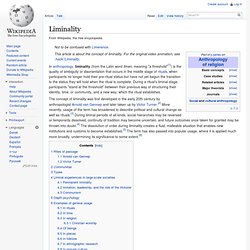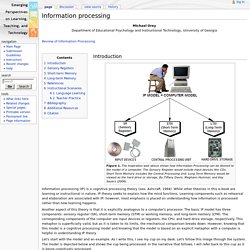

Www.graham-russell-pead.co.uk/articles-pdf/critical-reflection.pdf. Liminality. In anthropology, liminality (from the Latin word līmen, meaning "a threshold"[1]) is the quality of ambiguity or disorientation that occurs in the middle stage of rituals, when participants no longer hold their pre-ritual status but have not yet begun the transition to the status they will hold when the ritual is complete.

During a ritual's liminal stage, participants "stand at the threshold" between their previous way of structuring their identity, time, or community, and a new way, which the ritual establishes. Rites of passage[edit] Arnold van Gennep[edit] Van Gennep, who invented the term liminality, published in 1908 his Rites de Passage, a work that is essential to the development of the concept of liminality in the context of rituals in small-scale societies.
Van Gennep began his book by identifying the various categories of rites. This three-fold structure, as established by van Gennep, is made up of the following components:[9] Victor Turner[edit] Neither teacher-centred nor student-centred: threshold concepts and research partnerships. Jack Mezirow and Transformational Learning Theory. Jack Mezirow Transformational Learning by Sunny Cooper, M.S., M.Ed.

Literature on transformational learning was reviewed in four areas: (1) theories of transformational learning, (2) roles of participants in transformative programs, including students and instructors, (3) course content, environments and instructional activities as they relate to transformational learning, and (4) challenges for instructors who teach transformational material. Theories of Transformational Learning The study of transformational learning emerged with the work of Jack Mezirow (1981, 1994, 1997). Transformational learning is defined as learning that induces more far-reaching change in the learner than other kinds of learning, especially learning experiences which shape the learner and produce a significant impact, or paradigm shift, which affects the learner's subsequent experiences (Clark, 1993).
Two fundamental questions arise from these observations. Challenges for Instructors in Transformational Learning. Information processing. Michael Orey Department of Educational Psychology and Instructional Technology, University of Georgia Review of Information Processing Introduction Figure 1.

The Inspiration web above shows how Information Processing can be likened to the model of a computer. The Sensory Register would include input devices like CDs. Information processing (IP) is a cognitive processing theory (see, Ashcraft, 1994). Another aspect of this theory is that it is explicitly analogous to a computer's processor. Let's start with the model and an example. Caption: The illustration above represents my coffee cup example. Sensory Registers The best understood of the sensory registers (SRs) are for hearing (echoic) and seeing (iconic). Short-term Memory Short-term memory (STM) is also known as working memory, and is where consciousness exists. The Threshold Concept - reference list.